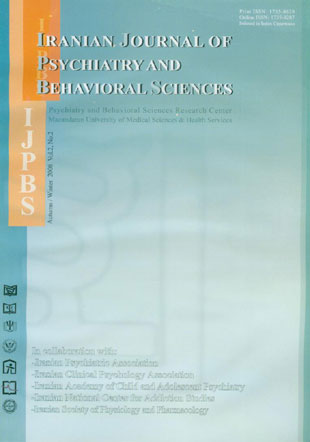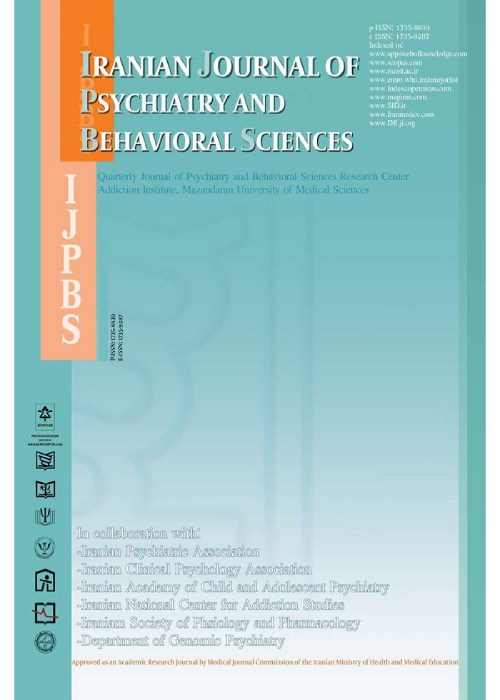فهرست مطالب

Iranian Journal of Psychiatry and Behavioral Sciences
Volume:2 Issue: 2, Jan 2008
- تاریخ انتشار: 1387/07/11
- تعداد عناوین: 18
-
-
Page 5reliability and validity of examinations in psychiatry have always been one of the major concerns of experts in this discipline. Recently, objective structured clinical examination (ÔSÇË) for its unique approach and by providing the requirements of psychiatric examinations has been a topic of interest. Ïn Ïran, an ÔSÇË has been replaced the individual patient assessment (ÏPÂ) for examination of the National Board of Psychiatry. Âlthough it is better to provide psychiatry ÔSÇË in an extended time frame, in some cases this examination should be executed in a short period of time. For executing ÔSÇË in psychiatry, especially if it should be performed in a short time, it requires addressing various points. Ïn this article, based upon the previous experiences, we offer a standard format for establishing a practical, reliable and measurable ÔSÇË in psychiatry in three days.
-
Page 10Ço-morbidity of personality disorders with illicit drug abuse has a deleterious effect on the management outcome of both conditions. This study was conducted to assess the prevalence of different personality disorders among substance dependent patients in an Ïranian city (Ïsfahan) with a view to have a better understanding of various management strategies.Methods total of 368 different patients with substance dependency (363 men, 5 women; mean age 29±9 years) were selected for the study. Üsing a Persian translation of DSM-ÏV, information was collected on (i) demographic data; and (ii) personality disorders criteria.Results total of 299 clients (81.3%) had at least one personality disorder. Lower level of education, younger age and being married were significantly associated with a higher prevalence of personality disorders.Çonclusion: Ôur findings indicate the importance of assessment of personality disorder for all patients with substance abuse/dependency in order to draw up a more effective management strategy
-
Page 15Ôbjective: Substance use, especially among young generation, is a public health concern. The aim of the current study was to explore the interrelation between certain variables including demographic characteristics and family history of drug abuse and history of depression among Ïranian Üniversity students.MethodsÏn a cross-sectional study, 843 college students of the Âzad Üniversity of Torbat Jaam (Khorasan province) completed a questionnaire containing data on demographic characteristics, lifelong and past month history of substance use, family history of substance use and different types of substance used by students. Participants also completed the Beck Depression Ïnventory.Results57.5% of those who took part in the study were male. 30.7% of the participants revealed a lifetime history of substance use (209 males and 55 females). Üse of alcohol, cigarette, cannabis, and opium was significantly higher among men. 14.9% of participants had used substances in the past month and 15.1% in the last year. Çigarette was the most commonly used substance (19.2%). The second and third most commonly used substances were opium (15.4%) and alcohol (10.8%). Beck Depression Ïnventory score was significantly higher among students with a history of substance use (p=0.000).Çonclusion: Substance use was commonly reported by the university students. This was significantly associated with a diagnosis of depression.
-
Comparing the Level of Dissociative Experience in Prisoners with and without Opioid Dependence Disorder in Shiraz and its Relationship with Other Psychiatric DisordersPage 18ObjectiveMany psychodynamic oriented psychotherapists believe that people do not become addicted without a reason; they use drugs to avoid painful feelings, thoughts and memories. The present study examines the relationship between the level of dissociation, substance dependence disorder and other psychiatric disorder.MethodsIn a descriptive study on prisoners of Adel-Abad prison, Shiraz, Iran, a sample of 4 groups of 29 women, and 30 men with opioid dependence, and 27 women and 30 men without dependence filled out the DES II questionnaire and SCL-90-R. The groups were compared regarding mean of DES with t-test and chi-square and also correlation coefficient for the relationship of DES and other psychiatric disorders.ResultsWomen with opioid dependence showed the highest score in DES II (mean=48.9) among the groups and men without substance use disorder had the least mean score in DES (24.27). The difference between addict and non-addict groups regarding DES was significant. There was no meaningful relationship between DES II score and 9 aspects of SCL-90-R.ConclusionThe results are suggestive of a relationship between addiction and dissociation. It is supposed if substance use disorder can be explained as a “Chemically Induced Dissociation”, or both “Dissociation” and “Substance Induced Disorder” might have common explanations in psychopathology.
-
Page 23Ôbjective: Working women are predisposed to some psychiatric symptoms or disorders due to their life styles or working conditions; such as long working hours, being away from their children during the day, and having various roles as an employee, a spouse, mother and a housekeeper, which creates daily stress, feelings of guilt, anxiety, dysphoric mood or interpersonal problems, all of which may lead to more serious mental disorders. Therefore, life skills training may help them to cope better with the problems of their life styles, and promote their mental health.MethodsÏn a semi-experimental study, 84 female university employees attended1-2 sessions of life skills training weekly for 10 weeks. The duration of each session was 2 hours. Participants completed a GHQ-28 form, prior to entering the training course, and again, 2 weeks after the completion of the workshops. The statistical test used in this study, was t test for dependent variables.Results number of participants exhibited psychiatric symptoms, such as suffering from depression, anxiety, psychosomatic disorder and social functioning problems. The scores of the means significantly reduced in post-test situations, except for depressive symptoms subscale which was minimal. The subscales of those whose total scores were above the cut off point (23) were reduced to half.Çonclusion: The result of this study shows that life skills training can be an effective method in reducing anxiety, sleep and somatic symptoms, as well as social function disorders, however, contrary to many published studies, LST had no impact on depressive symptoms of our subjects.
-
A Study of Factor Structure of the Mood Disorder Questionnaire in a Sample of Iranian Pregnant WomenPage 30Ôbjective: The Mood Disorder Questionnaire (MDQ) has been developed as a self-reporting, brief, and easy-to-use screening instrument to improve identification of bipolar mood disorders. The goals of the present study were to examine the prevalence of this disorder and interrelationship of its symptoms by factor analysis of MDQ in a group of pregnant women in Ïran.MethodsÔne thousand and eight hundred and ninety eight pregnant women in their third trimester were recruited to take part in a cross-sectional study. Trained local health workers administered MDQ for them. Â principal component factor analysis was used to determine factors for relevant items of MDQ questions.ResultsThe mean age of the participants was 25.4 ± 5.1 years. Âbout 3.9% of participants met the MDQ diagnostic criteria for bipolar mood disorder, and 19.6% scored positively for at least one Mood Disorder Questionnaire item and also had moderate to severe psychosocial impairment (second sample). The first factor analysis on the whole sample revealed elevated mood, increased self-confidence and energy, increased social activity and disinhibited sexual behavior as significant. Ïrritability, talkativeness, insomnia, racing thoughts, distractibility, risky behavior and overspending were determined as important by the second factor analysis.Çonclusion: Self-reporting of hypomanic symptoms by Ïranian pregnant women revealed a relatively high prevalence rate of Bipolar Spectrum Disorders. Study analysis also showed there were two independent factors: an energized-activity factor and an elevated mood-thought racing factor.
-
Page 35Ôbjective: Ït has been shown that serum and red blood cells’ level of Ômega-3 fatty acids are low in people with schizophrenia. Many studies have, therefore, attempted to explore the beneficial effects of these substances in the management of Schizophrenia. However, the outcomes of the previous studies have not been clear cut. The present study is an attempt to retest this hypothesis by eliminating some of the limitations of the previous studies.MethodsÏn a prospective double blind placebo-controlled clinical trial, 85 inpatients with schizophrenia randomly assigned to either risperidone plus Ômega-3 or risperidone plus placebo. Âfter a washout period, 44 patients received 2-8 mg/day of risperidone plus placebo and 43 patients received risperidone plus 3 gr/day of Ômega-3 for 6 weeks. The treatment effect was calculated by Friedman, Mann Whitney and t test. There were no significant differences between groups in age, sex, education, duration of illness and the number of previous hospitalizations.ResultsThere were no statistically significant differences in the scores of Positive and Negative Syndrome Scale between two groups at weeks 0, 3 and 6 and for the whole duration of the study.Çonclusion: Ïn our study, Ômega-3 fatty acids had no superiority to placebo in reducing the positive and negative symptoms of schizophrenia. However, due to a short duration of our study, we recommend that more long term clinical trials are needed in order to develop a better understanding of the therapeutic effects of the Ômega-3 fatty acids in the pharmacological management of schizophrenia.
-
Page 41Ôbjective: Çhaotic and unhealthy lifestyles in young generation will have a costly consequence for the health services in the future. The aim of the current study was to explore the way the Ïranian Üniversity students live in order to inform the way for provision of better preventive strategies against chronic physical and psychological disabilities.MethodsÇurrent study was carried out on 470 university students who completed a self administered questionnaire about various variables including their body mass index, nutritional status, physical activity, sleep pattern, physical and psychological wellbeing and substance use.ResultsÔur study revealed that, in general, some students, particularly those who were studying medicine, were not enjoying a healthy lifestyle. However, female students were doing better than males in this regard.Çonclusion: The findings of our study are overall in accord with the results of the studies published in other countries. This should inform policy makers and health service managers to develop health action programs for university students to promote healthy lifestyle.
-
Page 46Ôbjective: Previous studies reported that individuals with Parkinson’s disease are less likely to have smoking history and it seems that nicotine has a neuroprotective effect. The authors have conducted a case-control retrospective study to determine if there is an association between cigarette smoking and Parkinson’s disease.MethodsÏn a matched case-control study, 92 individuals with Parkinson’s disease (71 men, 21 women; mean age: 67.3±11 year) were compared to 184 people without such a diagnosis. (144 men, 40 women; mean age: 65.7±12.3 year).ResultsNineteen patients in the group with a diagnosis of Parkinson’s disease (20.6%) were smoker. Ïn the control group, however, there were 103 smokers. Âlso, we found a dose-response correlation between amount of smoking and higher risk of having Parkinson’s disease.Çonclusion: Çonsistent with the results of previous studies, we found that individuals with Parkinson’s disease are significantly less likely to have smoked regularly than those without Parkinson’s disease
-
Page 55Drug abuse has high co-morbidity with mental disorders, thus, controlling and treating it requires multimodal treatment intervention. This cross sectional study evaluates personality traits of 67 ÏV heroin abusers in Kashan Prison. The utilized instruments included two parts: a demographic questionnaire and MMPÏ. The data obtained from the questionnaires were statistically analyzed by using Fisher exact test. Fifty (%74/62) participants suffered from abnormal personality traits. Most of them were single and less than 30 years of age. Prominent personality traits were antisocial and depressed. There was a significant relation between abnormal personality traits and educational levels.
-
Third National congress of sociocultural psychiatry of iranPage 61
-
Excent from persian psychiatric and behavioral sciences litteraturePage 62
-
Page 73


